Computer Modeling of Barrel-Vaulted Sanctuary Exhibiting Flutter Echo with Comparison to Measurements
Abstract
1. Introduction
2. Methods
2.1. Measurements
2.1.1. Room Configuration
2.1.2. Measurement Equipment
2.1.3. Source and Receiver Locations
2.2. Computer Modeling
2.2.1. Geometrical Acoustics (GA) Methods
2.2.2. GA Computer Modeling Methodology
2.2.3. Wave-Based Methods
2.2.4. Wave-Based Computer Modeling Methodology
2.3. Signal Processing of Room Impulse Response
- Spectrogram Analysis: Spectrograms were generated from 48 kHz sampled RIR data using a 10 ms Hann window with 120 sample overlap.
- Reverberation Time: Reverberation times (T(20) and T(30)) were calculated from the 48 kHz sampled RIR data for the 125–8000 Hz octave bands using the ITA toolbox [65].
- Energy Decay Curve: The energy decay curves were generated from the 48 kHz sampled RIR data using the ITA toolbox. The curves were normalized and plotted in dB using P = 20 over a 40 dB reduction in SPL.
2.4. Wavelet Multi-Resolution Analysis
Wavelet Selection
- The differences between the wavelet types which they applied were insignificant, therefore, any of the tested wavelet families could be applied with similar results.
- The length of the wavelet had a significant effect on the uniformity of the results, where wavelets with longer support gave rise to more consistent results.
3. Results and Discussion
- R01 and R04: As both of these figures are the same distance from the sound source, with one located on the aisle and the other located off the aisle, comparison between these two points demonstrates the non-diffuse nature of the room.
- Original and Panel (with R01 and R04): In order to demonstrate the changes in the room acoustics as a result of the addition of acoustical panels, some figures feature side-by-side comparisons of the original room configuration and the room configured with panels as shown in Figure 4.
- R03, R04 and R05: These three receiver locations represent three different heights at the same location in the room as shown in Figure 3. This comparison demonstrates the unique behavior of the flutter echo at different heights relative to the source height.
3.1. RIR Spectrogram
- Behavior of the room on and off the aisle: Comparison of Figure 7 and Figure 8, demonstrates the non-diffuse nature of the room. As stated earlier, both receiver points R01 and R04 are the same distance from the sound source, however, because of their location with respect to the barrel-vaulted ceiling, their spectrograms display very different behaviors.In high frequencies, above 4000 Hz, the measured original R01 and R04 spectrograms exhibit similar behavior, with the majority of the energy having died out by 0.5 s. Below 4000 Hz, the behavior of the two locations are quite different. In the audience, the signal dies out almost completely by 1.5 s, while in the aisle, it remains well beyond 4 s. Additionally, the signal is characterized by a periodic pattern representative of the flutter echo present in the aisle. Furthermore, along the aisle, it is possible to identify the comb filter behavior expected from a flutter echo.
- Behavior of room before and after the addition of panels: In order to demonstrate the changes in the room acoustics as a result of the addition of acoustical panels, some figures feature side-by-side comparisons of the original room configuration and the room configured with panels as shown in Figure 1.Similar to what was observed in the comparison of R01 and R04, at higher frequencies (above 4000 Hz), the addition of the panels had very little effect on the spectrogram. Below 4000 Hz, in the audience area, the addition of the panels reduces the energy, such that the signal is essentially eliminated after 1.5 s. On the aisle, the effect of the panels is more pronounced, with the primary effect being to eliminate the majority of the late decay energy in the 250–2000 Hz octave bands after 2 s. The panels also have a secondary effect of reducing the amplitude of the peaks from 0.5 to 1.5 s.These results indicate that the panels had the desired effect of reducing the RT along the aisle without completely eliminating the spacious feel of the room promoted by the flutter echo.
- Comparison of the GA and wave-based modeling with the measured data: The spectrograms provide a means of comparison of the similarities and distinctions between the measured data and the two different modeling techniques, GA and wave-based. Comparison between measured and modeled response before 0.5 s highlights specific early behaviors (before 0.5 s) and later behaviors. Before 0.5 s, both models contain more energy above 8 kHz than the measured data, with Odeon predicting much more sustained high frequency energy. It is important to note that above 8 kHz, both Odeon and the wave-based model use ray-tracing techniques. Also, the measured data has a band of higher energy sustained past 0.5 s around 6500 Hz, which is not identified in the wave-based model.Most significantly, the very distinct pattern of the flutter echo detected in measurements on the aisle in Figure 8, are clearly identified in the wave-based model, but are not present in the spectrogram of the Odeon model RIR.
3.2. RIR Reverberation Times
3.3. Energy Decay Curves
3.4. Wavelet Multi-Resolution Analysis
3.4.1. Comparison of Flutter Echo On and Off the Aisle
3.4.2. Comparison of Flutter Echo Before and After the Addition of Panels
3.4.3. Structure of Triplets Based on Receiver Height
4. Conclusions
Author Contributions
Funding
Acknowledgments
Conflicts of Interest
References
- Krokstad, A.; Strom, S.; Sørsdal, S. Calculating the acoustical room response by the use of a ray tracing technique. J. Sound Vib. 1968, 8, 118–125. [Google Scholar] [CrossRef]
- Schroeder, M.R. Computer models for concert hall acoustics. Am. J. Phys. 1973, 41, 461–471. [Google Scholar] [CrossRef]
- Cremer, L.; Müller, H.; Schultz, T. Principles and Applications of Room Acoustics, Volume 1; Applied Science Publishers Ltd.: London, UK, 1982. [Google Scholar]
- Vorländer, M. Simulation of the transient and steady-state sound propagation in rooms using a new combined ray-tracing/image-source algorithm. J. Acoust. Soc. Am. 1989, 86, 172. [Google Scholar] [CrossRef]
- Savioja, L.; Svensson, U.P. Overview of geometrical room acoustic modeling techniques. J. Acoust. Soc. Am. 2015, 138, 708–730. [Google Scholar] [CrossRef]
- Dalenbäck, B.I. A New Model for Room Acoustic Prediction and Auralization. Ph.D. Thesis, Chalmers University of Technology, Gothenburg, Sweden, 1995. [Google Scholar]
- Naylor, G.M. ODEON—Another hybrid room acoustical model. Appl. Acoust. 1993, 38, 131–143. [Google Scholar] [CrossRef]
- Shuku, T.; Ishihara, K. The analysis of the acoustic field in irregularly shaped rooms by the finite element method. J. Sound Vib. 1973, 29, 67–76, IN1. [Google Scholar] [CrossRef]
- Chiba, O.; Kashiwa, T.; Shimoda, H.; Kagami, S.; Fukai, I. Analysis of sound fields in three dimensional space by the time-dependent finite-difference method based on the leap frog algorithm. J. Acoust. Soc. Jpn. 1993, 49, 551–562. [Google Scholar]
- Botteldooren, D. Acoustical finite-difference time-domain simulation in a quasi-Cartesian grid. J. Acoust. Soc. Am. 1994, 95, 2313–2319. [Google Scholar] [CrossRef]
- Savioja, L.; Rinne, T.J.; Takala, T. Simulation of Room Acoustics with a 3-D finite difference mesh. In Proceedings of the International Computer Music Conference (ICMC), Aarhus, Denmark, 12–17 September 1994; pp. 463–466. [Google Scholar]
- Kowalczyk, K.; van Walstijn, M. Room acoustics simulation using 3-D compact explicit FDTD schemes. IEEE Trans. Audio Speech Lang. Process. 2011, 19, 34–46. [Google Scholar] [CrossRef]
- Hargreaves, J.A. Time Domain Boundary Element Method for Room Acoustics. Ph.D. Thesis, University of Salford, Salford, UK, 2007. [Google Scholar]
- Sakuma, T.; Sakamoto, S.; Otsuru, T. Computational Simulation in Architectural and Environmental Acoustics; Springer: Berlin, Germany, 2014. [Google Scholar]
- Savioja, L. Real-time 3D finite-difference time-domain simulation of low-and mid-frequency room acoustics. In Proceedings of the International Conference on Digital Audio Effects (DAFx), Graz, Austria, 6–10 September 2010; Volume 1, p. 75. [Google Scholar]
- Webb, C.J.; Bilbao, S. Computing room acoustics with CUDA - 3D FDTD schemes with boundary losses and viscosity. In Proceedings of the IEEE International Conference on Acoustics, Speech, and Signal Processing (ICASSP), Prague, Czech Republic, 22–27 May, 2011; pp. 317–320. [Google Scholar]
- López, J.J.; Carnicero, D.; Ferrando, N.; Escolano, J. Parallelization of the finite-difference time-domain method for room acoustics modelling based on CUDA. Math. Comput. Model. 2013, 57, 1822–1831. [Google Scholar] [CrossRef]
- Van Mourik, J.; Murphy, D. Explicit higher-order FDTD schemes for 3D room acoustic simulation. IEEE/ACM Trans. Audio Speech Lang. Process. 2014, 22, 2003–2011. [Google Scholar] [CrossRef]
- Spa, C.; Rey, A.; Hernandez, E. A GPU implementation of an explicit compact FDTD algorithm with a digital impedance filter for room acoustics applications. IEEE/ACM Trans. Audio Speech Lang. Process. 2015, 23, 1368–1380. [Google Scholar] [CrossRef]
- Saarelma, J.; Califa, J.; Mehra, R. Challenges of Distributed Real-Time Finite-Difference Time-Domain Room Acoustic Simulation for Auralization. In Proceedings of the AES International Conference on Spatial Reproduction-Aesthetics and Science, Tokyo, Japan, 7–9 August 2018. [Google Scholar]
- Saarelma, J.; Savioja, L. An Open Source Finite difference Time-domain Solver for Room Acoustics Using Graphics Processing Units. In Proceedings of the Forum Acusticum, Krakow, Poland, 7–12 September 2014. [Google Scholar]
- Weitze, C.A.; Rindel, J.H.; Christensen, C.L.; Gade, A.C. The acoustical history of Hagia Sophia revived through computer simulation. In Proceedings of the Forum Acusticum, Sevilla, Spain, 16–20 September 2002. [Google Scholar]
- Postma, B.N.; Katz, B.F. Perceptive and objective evaluation of calibrated room acoustic simulation auralizations. J. Acoust. Soc. Am. 2016, 140, 4326–4337. [Google Scholar] [CrossRef] [PubMed]
- Boren, B.; Longair, M.; Orlowski, R. Acoustic simulation of renaissance venetian churches. Acoust. Pract. 2013, 1, 17–28. [Google Scholar] [CrossRef]
- Foteinou, A.; Murphy, D.T. Perceptual validation in the acoustic modeling and auralisation of heritage sites: The acoustic measurement and modelling of St Margaret’s Church, York, UK’. In Proceedings of the Conference on the Acoustics of Ancient Theatres, Patras, Greece, 18–21 September 2011; pp. 18–21. [Google Scholar]
- Oxnard, S.; Murphy, D.T. Achieving convolution-based reverberation through use of geometric acoustic modeling techniques. In Proceedings of the 15th International Conference on Digital Audio Effects (DAFx12), York, UK, 17–21 September 2012; p. 105. [Google Scholar]
- Alvarez-Morales, L.; Martellotta, F. A geometrical acoustic simulation of the effect of occupancy and source position in historical churches. Appl. Acoust. 2015, 91, 47–58. [Google Scholar] [CrossRef]
- Van Mourik, J.; Oxnard, S.; Foteinou, A.; Murphy, D.T. Hybrid acoustic modelling of historic spaces using blender. In Proceedings of the Forum Acusticum, Krakow, Poland, 7–12 September 2014. [Google Scholar]
- Oxnard, S. Efficient Hybrid Virtual Room Acoustic Modelling. Ph.D. Thesis, University of York, York, UK, 2016. [Google Scholar]
- D’Orazio, D.; De Cesaris, S.; Morandi, F.; Garai, M. The aesthetics of the Bayreuth Festspielhaus explained by means of acoustic measurements and simulations. J. Cult. Herit. 2018, 34, 151–158. [Google Scholar] [CrossRef]
- Azad, H.; Ketabi, R.; Siebein, G. A Study of Diffusivity in Concert Halls Using Large Scale Acoustic Wave-Based Modeling and Simulation. In Proceedings of the 47th International Congress and Exposition on Noise Control Engineering, Inter-Noise 2018, Chicago, IL, USA, 26–29 August 2018; pp. 5431–5442. [Google Scholar]
- D’Orazio, D.; Rovigatti, A.; Garai, M. The Proscenium of Opera Houses as a Disappeared Intangible Heritage: A Virtual Reconstruction of the 1840s Original Design of the Alighieri Theatre in Ravenna. Acoustics 2019, 1, 694–710. [Google Scholar] [CrossRef]
- Hornikx, M. Acoustic modelling of indoor and outdoor spaces. J. Build. Perform. Simul. 2015, 8, 1–2. [Google Scholar] [CrossRef]
- Shtrepi, L. Investigation on the diffusive surface modeling detail in geometrical acoustics based simulations. J. Acoust. Soc. Am. 2019, 145, EL215–EL221. [Google Scholar] [CrossRef]
- Iannace, G.; Trematerra, A.; Masullo, M. The large theatre of Pompeii: Acoustic evolution. Build. Acoust. 2013, 20, 215–227. [Google Scholar] [CrossRef]
- Lokki, T.; Southern, A.; Siltanen, S.; Savioja, L. Acoustics of Epidaurus–studies with room acoustics modelling methods. Acta Acust. United Acust. 2013, 99, 40–47. [Google Scholar] [CrossRef]
- Bo, E.; Shtrepi, L.; Pelegrín Garcia, D.; Barbato, G.; Aletta, F.; Astolfi, A. The Accuracy of Predicted Acoustical Parameters in Ancient Open-Air Theatres: A Case Study in Syracusae. Appl. Sci. 2018, 8, 1393. [Google Scholar] [CrossRef]
- Rindel, J.H. The use of computer modeling in room acoustics. J. Vibroeng. 2000, 3, 219–224. [Google Scholar]
- Maa, D.Y. The flutter echoes. J. Acoust. Soc. Am. 1941, 13, 170–178. [Google Scholar] [CrossRef]
- Morse, P.M. Vibration and Sound; McGraw-Hill: New York, NY, USA, 1948; Volume 2. [Google Scholar]
- Martellotta, F.; Álvarez-Morales, L.; Girón, S.; Zamarreño, T. An investigation of multi-rate sound decay under strongly non-diffuse conditions: The crypt of the cathedral of Cadiz. J. Sound Vib. 2018, 421, 261–274. [Google Scholar] [CrossRef]
- Moreno, A.; Zaragoza, J.G.; Alcantarilla, F. Generation and suppression of flutter echoes in spherical domes. J. Acoust. Soc. Jpn. (E) 1981, 2, 197–202. [Google Scholar] [CrossRef][Green Version]
- Lai, H.L.; Balant, A.C.; Foote, D.J. Case study: Measurement and treatment of severe flutter echo caused by a barrel-vaulted sanctuary ceiling. Noise Control. Eng. J. 2019, 67, 380–393. [Google Scholar] [CrossRef]
- Hamilton, B.; Webb, C.J.; Fletcher, N.D.; Bilbao, S. Finite difference room acoustics simulation with general impedance boundaries and viscothermal losses in air: Parallel implementation on multiple GPUs. In Proceedings of the International Symposium on Music and Room Acoustics (ISMRA), La Plata, Argentina, 11–13 September 2016. [Google Scholar]
- Lai, H.L.; Foote, D.J. Measurement, visualization, and modeling of acoustics of a barrel-vaulted sanctuary. J. Acoust. Soc. Am. 2017, 141, 3777. [Google Scholar] [CrossRef]
- ISO. Acoustics—Measurement of Room Acoustic Parameters—Part 1: Performance Spaces; ISO 3382-1:2009; International Organization for Standardization: Geneva, Switzerland, 2009. [Google Scholar]
- Kuttruff, H. Room Acoustics; CRC Press: Boca Raton, FL, USA, 2009. [Google Scholar]
- Cox, T.J.; Dalenback, B.I.; D’Antonio, P.; Embrechts, J.J.; Jeon, J.Y.; Mommertz, E.; Vorländer, M. A tutorial on scattering and diffusion coefficients for room acoustic surfaces. Acta Acust. United Acust. 2006, 92, 1–15. [Google Scholar]
- Pierce, A.D. Acoustics: An Introduction to its Physical Principles and Applications; McGraw-Hill: New York, NY, USA, 1989. [Google Scholar]
- Keller, J.B. Geometrical theory of diffraction. J. Opt. Soc. Am. 1962, 52, 116. [Google Scholar] [CrossRef]
- Svensson, U.P.; Fred, R.I.; Vanderkooy, J. An analytic secondary source model of edge diffraction impulse responses. J. Acoust. Soc. Am. 1999, 106, 2331–2344. [Google Scholar] [CrossRef]
- Schröder, D. Physically Based Real-Time Auralization of Interactive Virtual Environments; Logos Verlag Berlin GmbH: Berlin, Germany, 2011; Volume 11. [Google Scholar]
- Odeon A/S. Odeon Room Acoustics Software, User Manual; Version 15; Odeon A/S: Lyngby, Denmark, 2018. [Google Scholar]
- Heinz, R. Binaural room simulation based on an image source model with addition of statistical methods to include the diffuse sound scattering of walls and to predict the reverberant tail. Appl. Acoust. 1993, 38, 145–159. [Google Scholar] [CrossRef]
- Vorländer, M. Computer simulations in room acoustics: Concepts and uncertainties. J. Acoust. Soc. Am. 2013, 133, 1203–1213. [Google Scholar] [CrossRef] [PubMed]
- Vorländer, M. Auralization: Fundamentals of Acoustics, Modelling, Simulation, Algorithms and Acoustic Virtual Reality; Springer Science & Business Media: Berlin/Heidelberg, Germany, 2007. [Google Scholar]
- Hairer, E.; Lubich, C.; Wanner, G. Geometric numerical integration illustrated by the Störmer–Verlet method. Acta Numer. 2003, 12, 399–450. [Google Scholar] [CrossRef]
- Hamilton, B.; Webb, C.J.; Gray, A.; Bilbao, S. Large stencil operations for GPU-based 3-D acoustics simulations. In Proceedings of the International Conference on Digital Audio Effects (DAFx), Trondheim, Norway, 30 November–3 December 2015. [Google Scholar]
- Bilbao, S. Modeling of Complex Geometries and Boundary Conditions in Finite Difference/Finite Volume Time Domain Room Acoustics Simulation. IEEE Trans. Audio Speech Lang. Process. 2013, 21, 1524–1533. [Google Scholar] [CrossRef]
- Bilbao, S.; Hamilton, B.; Botts, J.; Savioja, L. Finite Volume Time Domain Room Acoustics Simulation under General Impedance Boundary Conditions. IEEE/ACM Trans. Audio Speech Lang. Process. 2016, 24, 161–173. [Google Scholar] [CrossRef]
- Bilbao, S.; Hamilton, B. Wave-based Room Acoustics Simulation: Explicit/Implicit Finite Volume Modeling of Viscothermal Losses and Frequency-dependent Boundaries. J. Audio Eng. Soc. 2017, 65, 78–89. [Google Scholar] [CrossRef]
- Hamilton, B. Finite Difference and Finite Volume Methods for Wave-based Modelling of Room Acoustics. Ph.D. Thesis, University of Edinburgh, Edinburgh, UK, 2016. [Google Scholar]
- Hamilton, B.; Webb, C.J. Room Acoustics Modelling Using GPU-accelerated Finite Difference and Finite Volume Methods on a Face-centered Cubic Grid. In Proceedings of the International Conference on Digital Audio Effects (DAFx), Maynooth, Ireland, 2–5 September 2013; pp. 336–343. [Google Scholar]
- Smith, J.O. Digital Audio Resampling Home Page. 2002. Available online: http://ccrma.stanford.edu/~jos/resample/ (accessed on 17 October 2019).
- Berzborn, M.; Bomhardt, R.; Klein, J.; Richter, J.G.; Vorländer, M. The ITA-Toolbox: An open source MATLAB toolbox for acoustic measurements and signal processing. In Proceedings of the 43th Annual German Congress on Acoustics, Kiel, Germany, 6–9 March 2017. [Google Scholar]
- Wiltschko, A.B.; Gage, G.J.; Berke, J.D. Wavelet filtering before spike detection preserves waveform shape and enhances single-unit discrimination. J. Neurosci. Methods 2008, 173, 34–40. [Google Scholar] [CrossRef]
- Zhang, Z.; Telesford, Q.K.; Giusti, C.; Lim, K.O.; Bassett, D.S. Choosing wavelet methods, filters, and lengths for functional brain network construction. PLoS ONE 2016, 11, e0157243. [Google Scholar] [CrossRef]
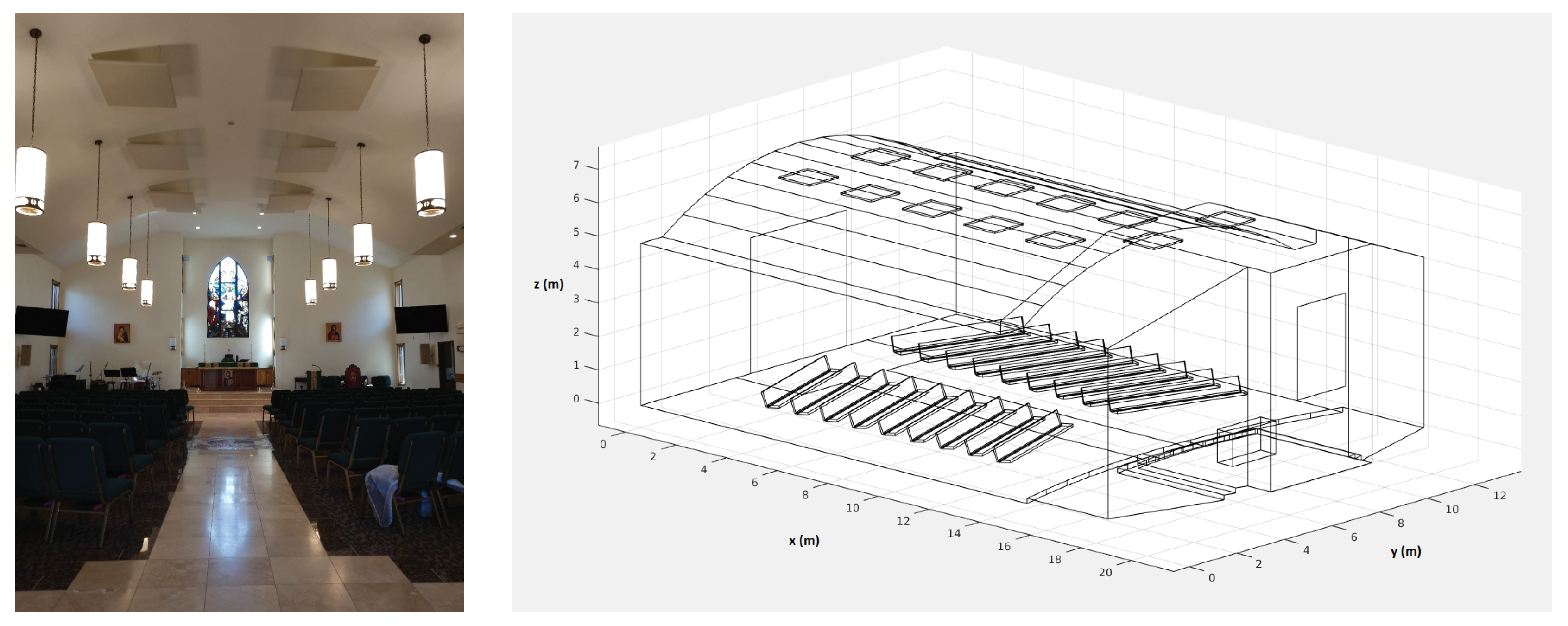

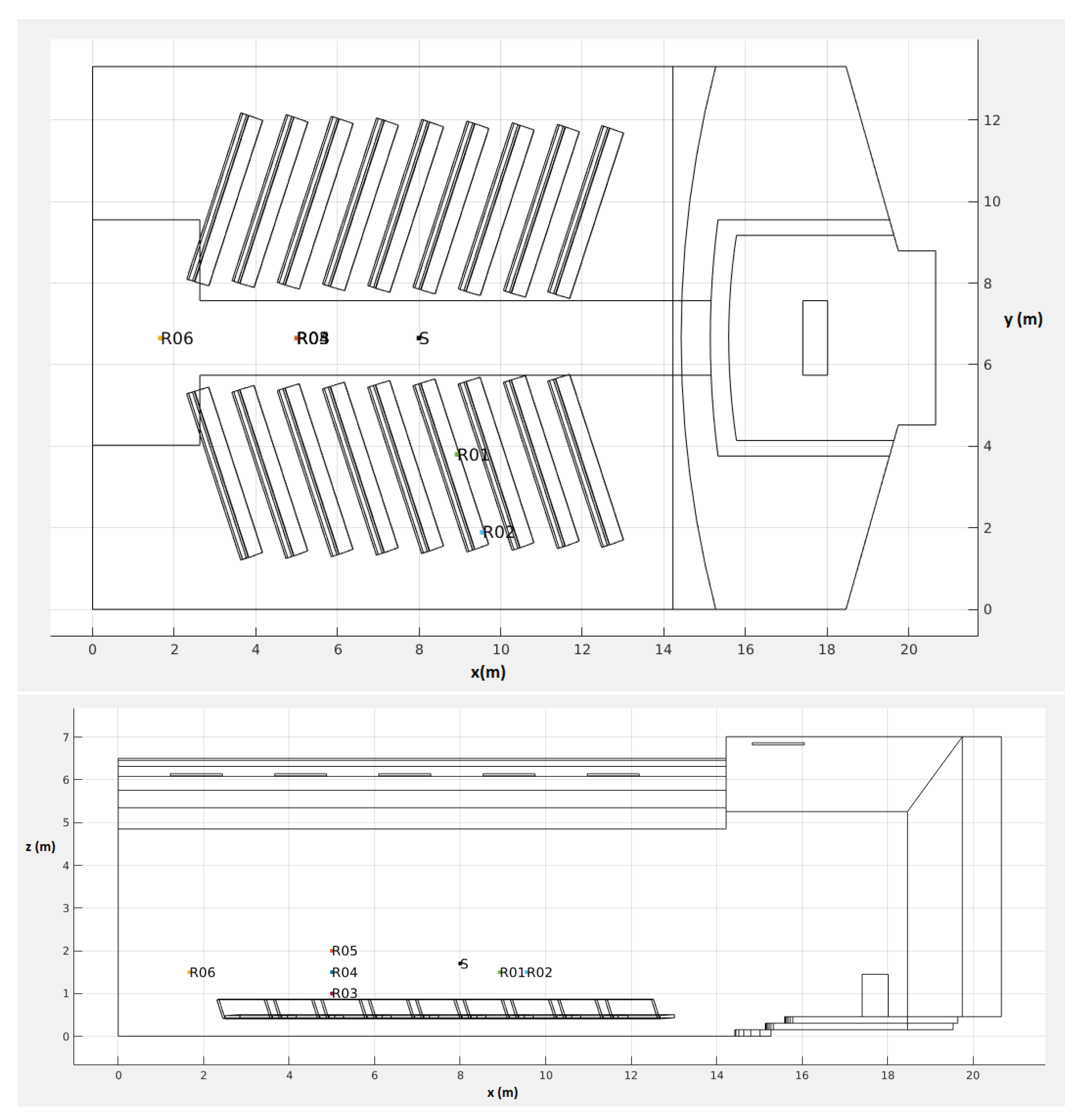

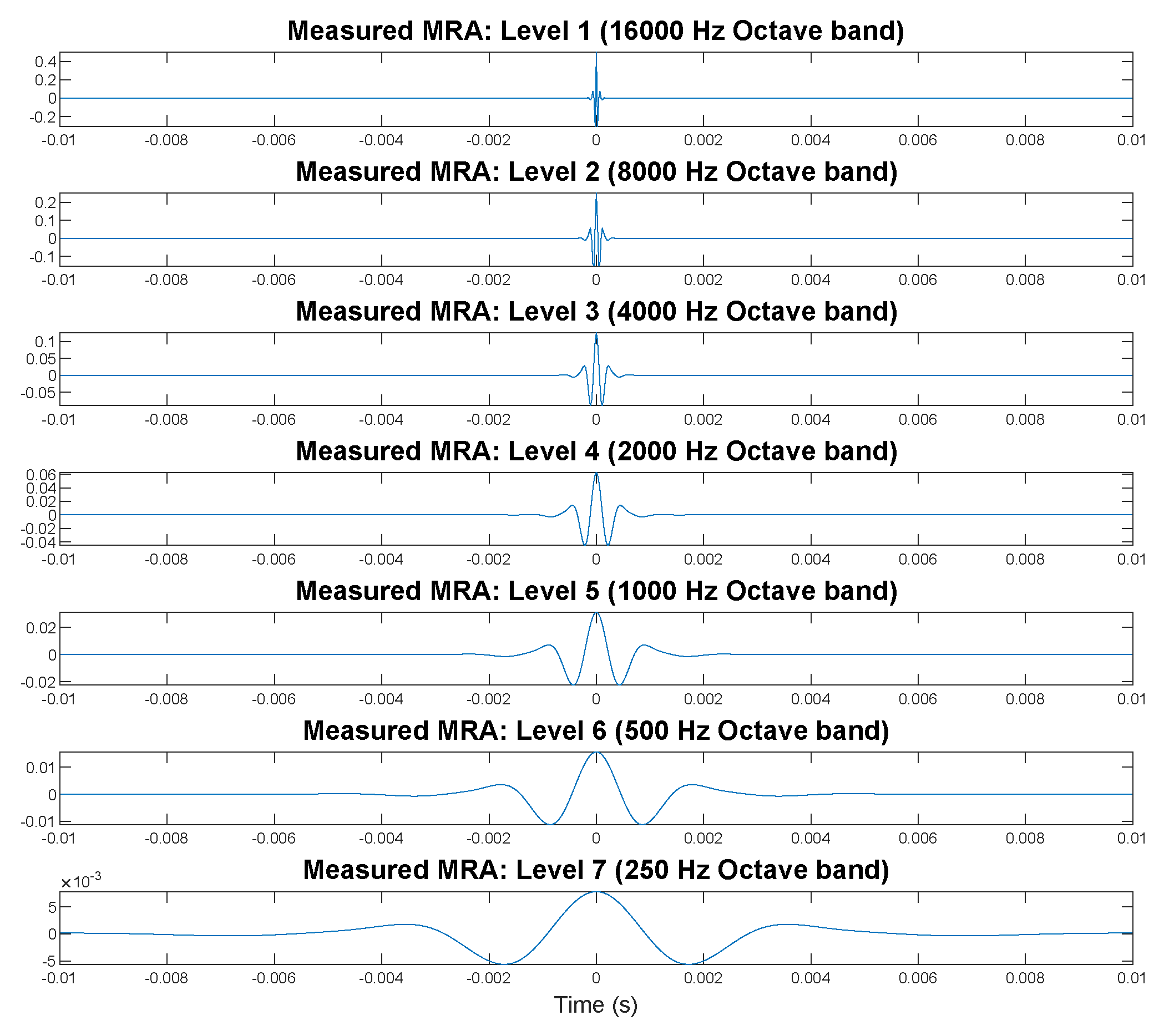
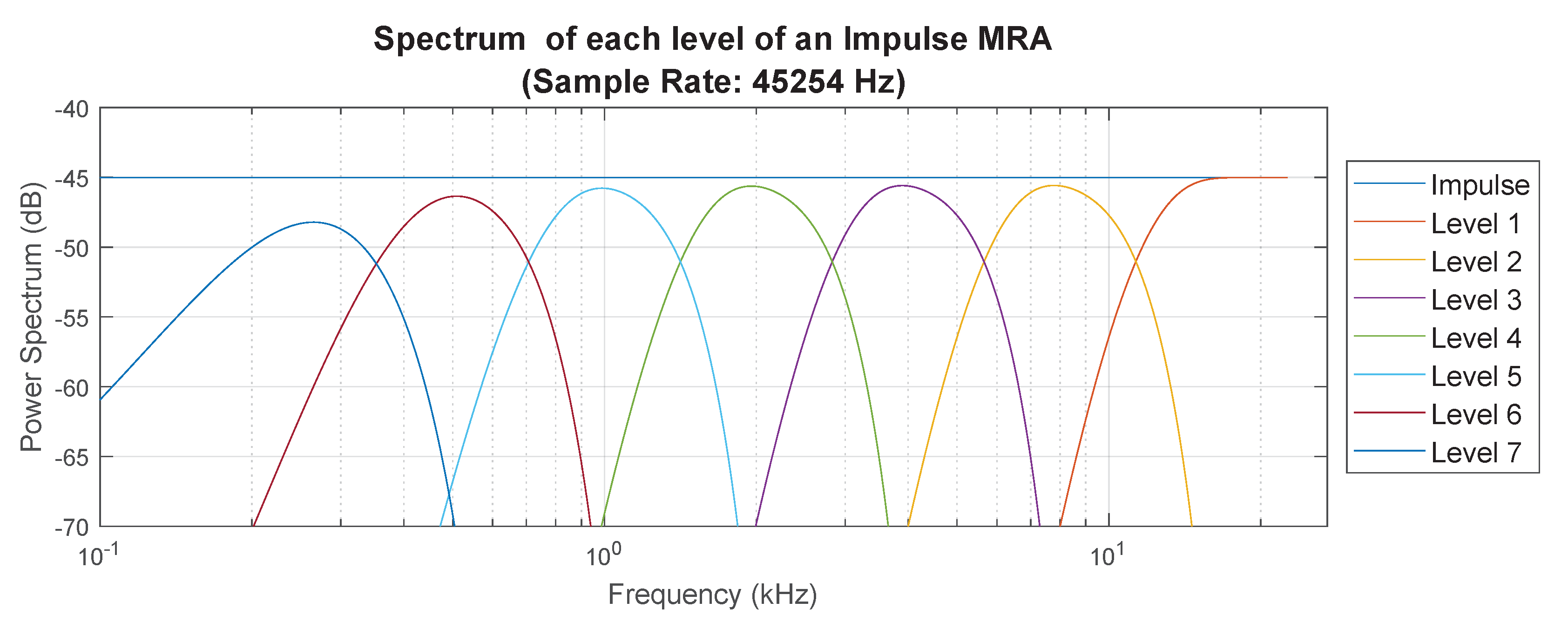
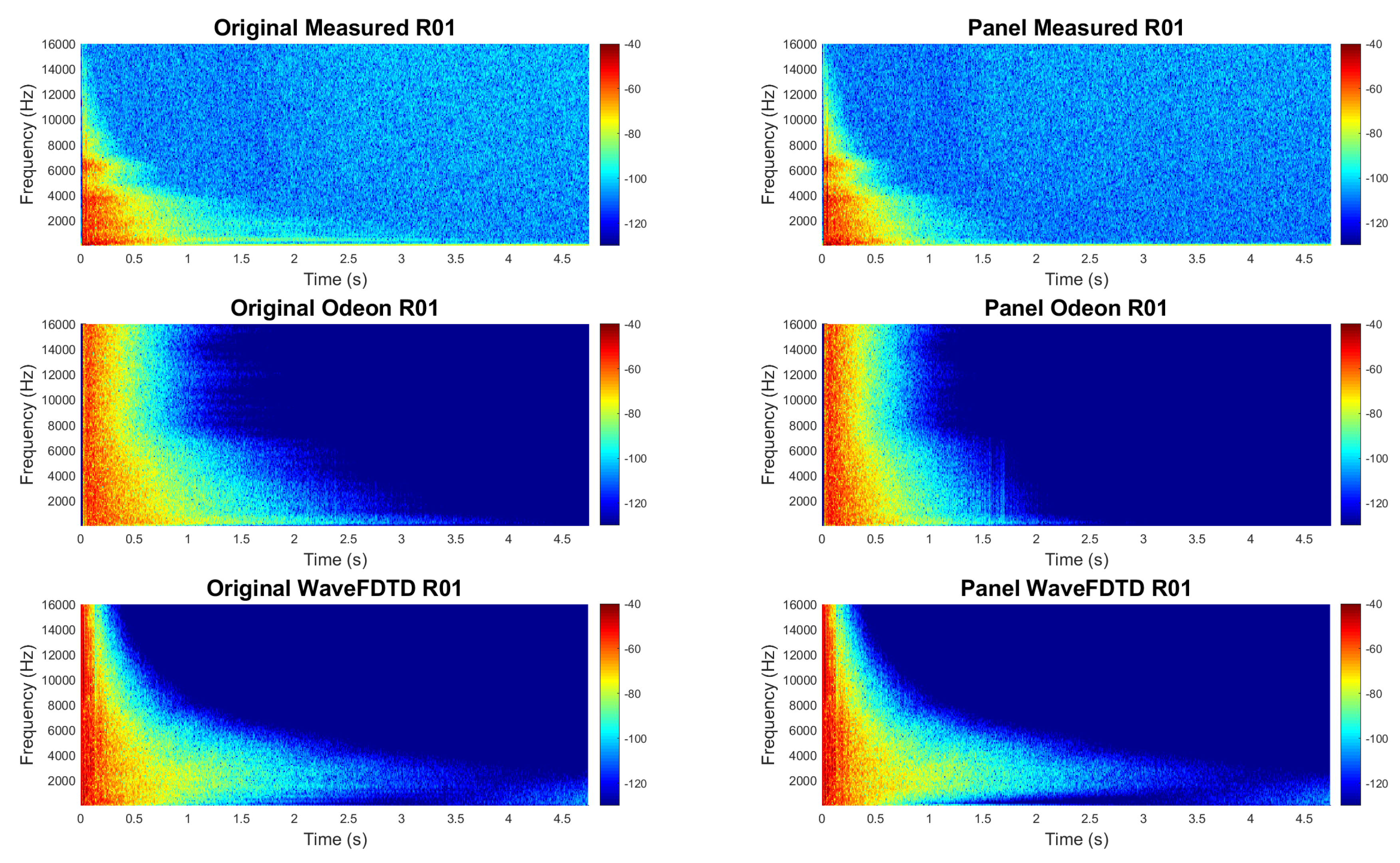
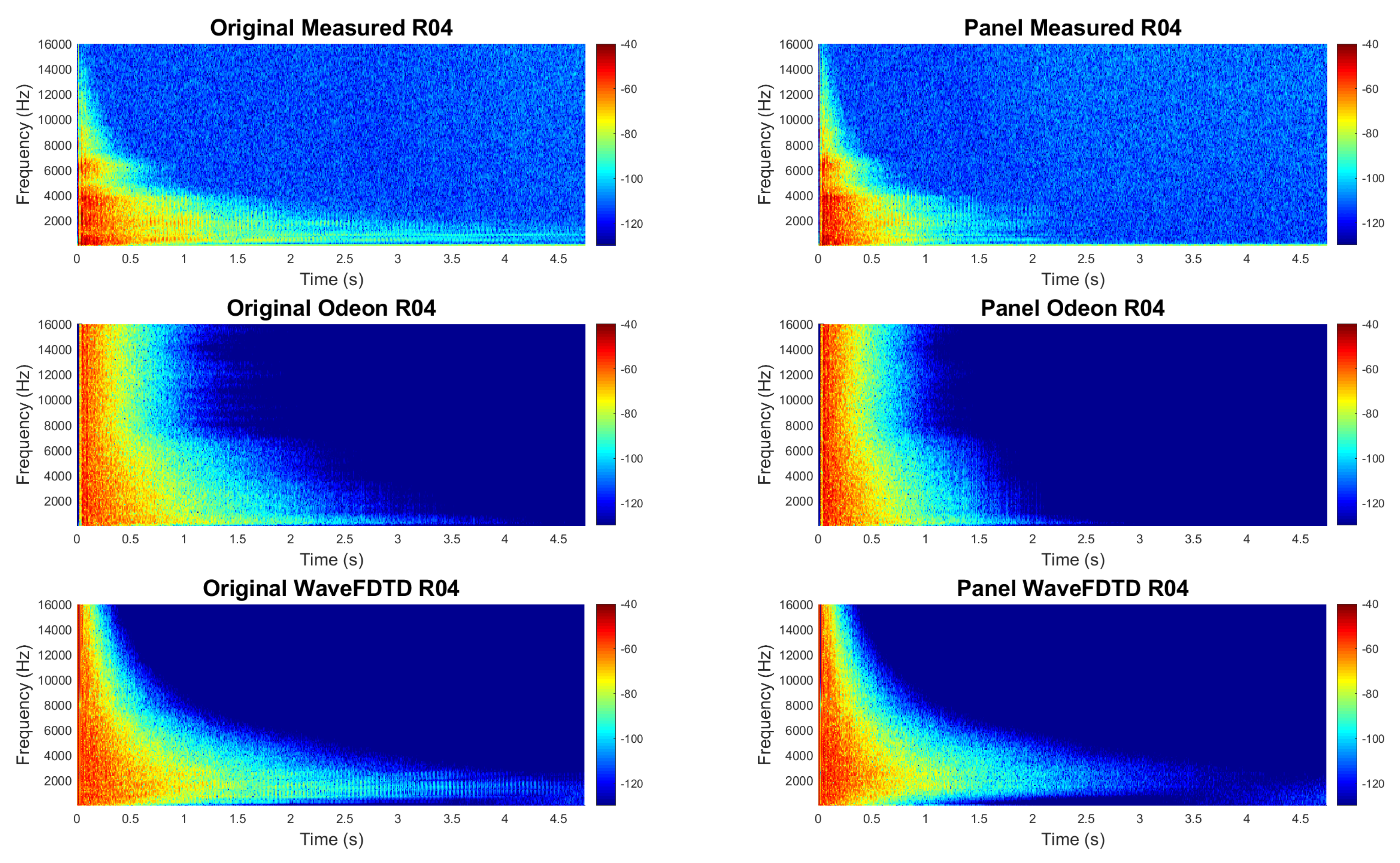
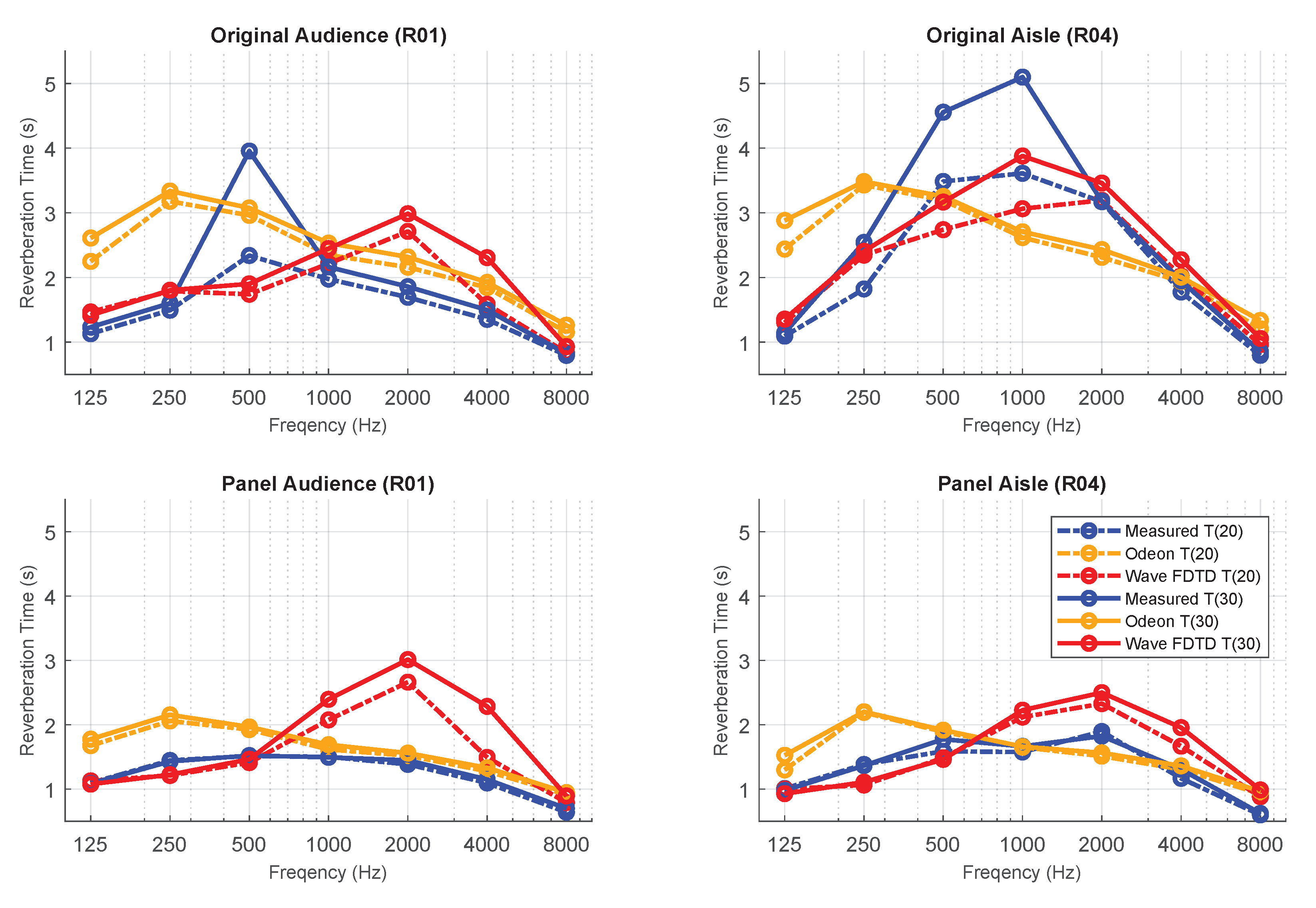
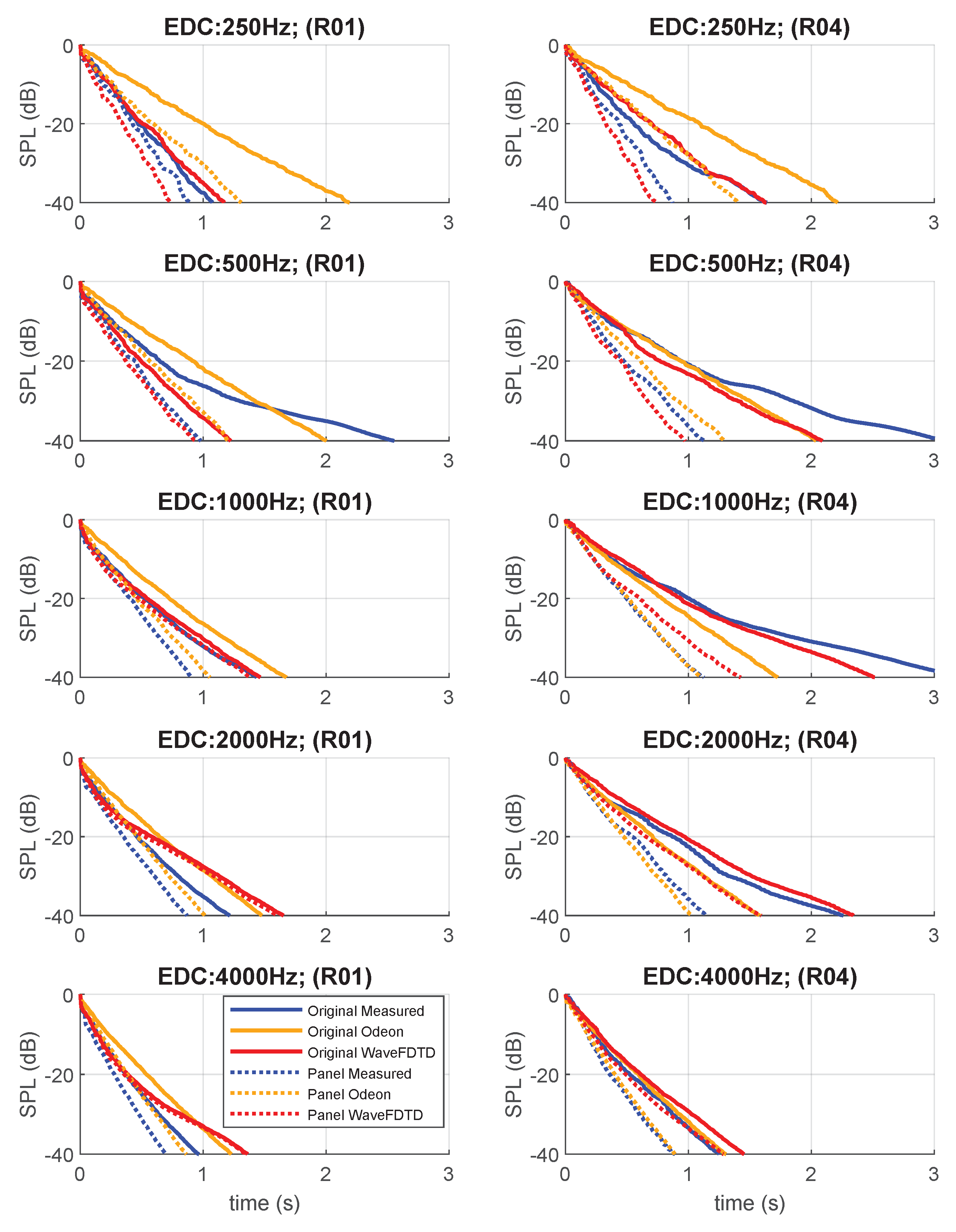
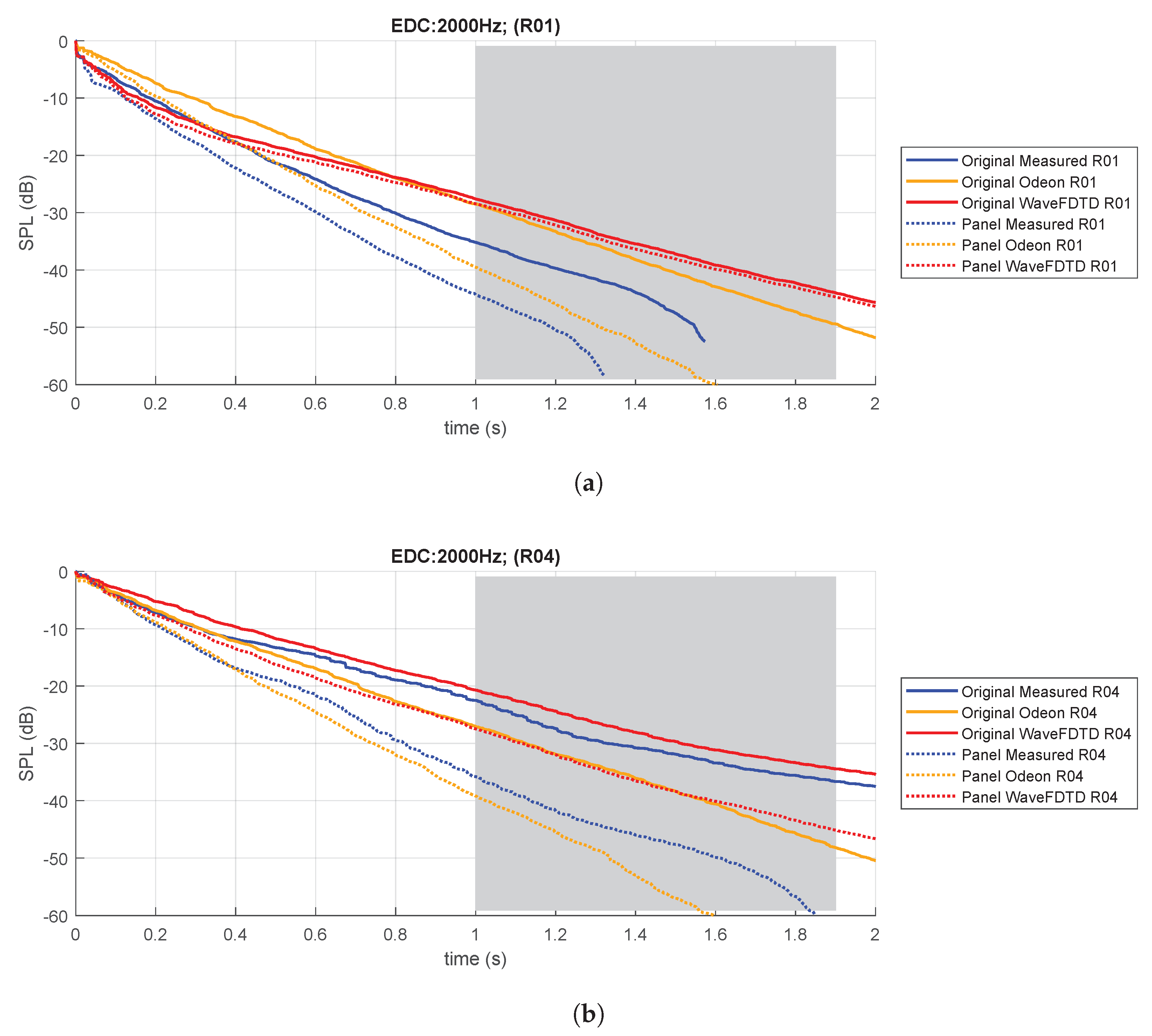
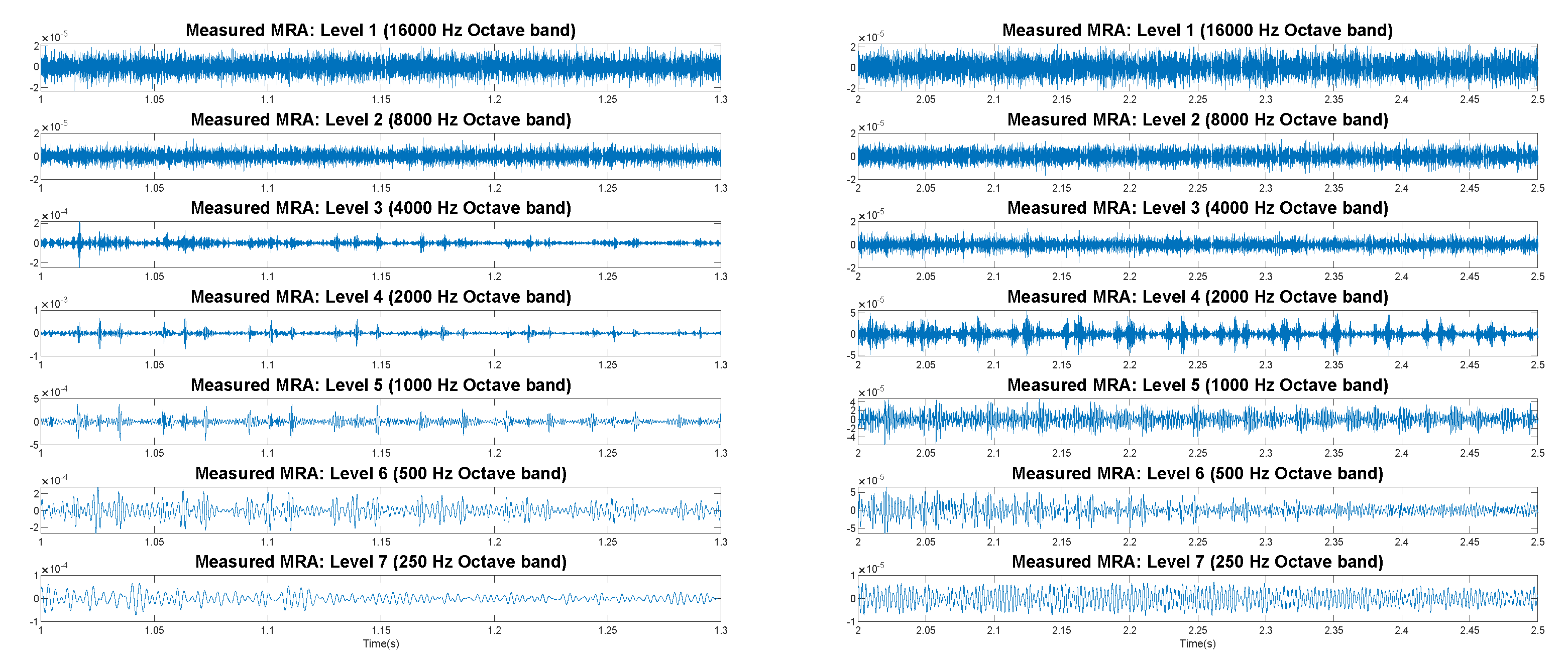
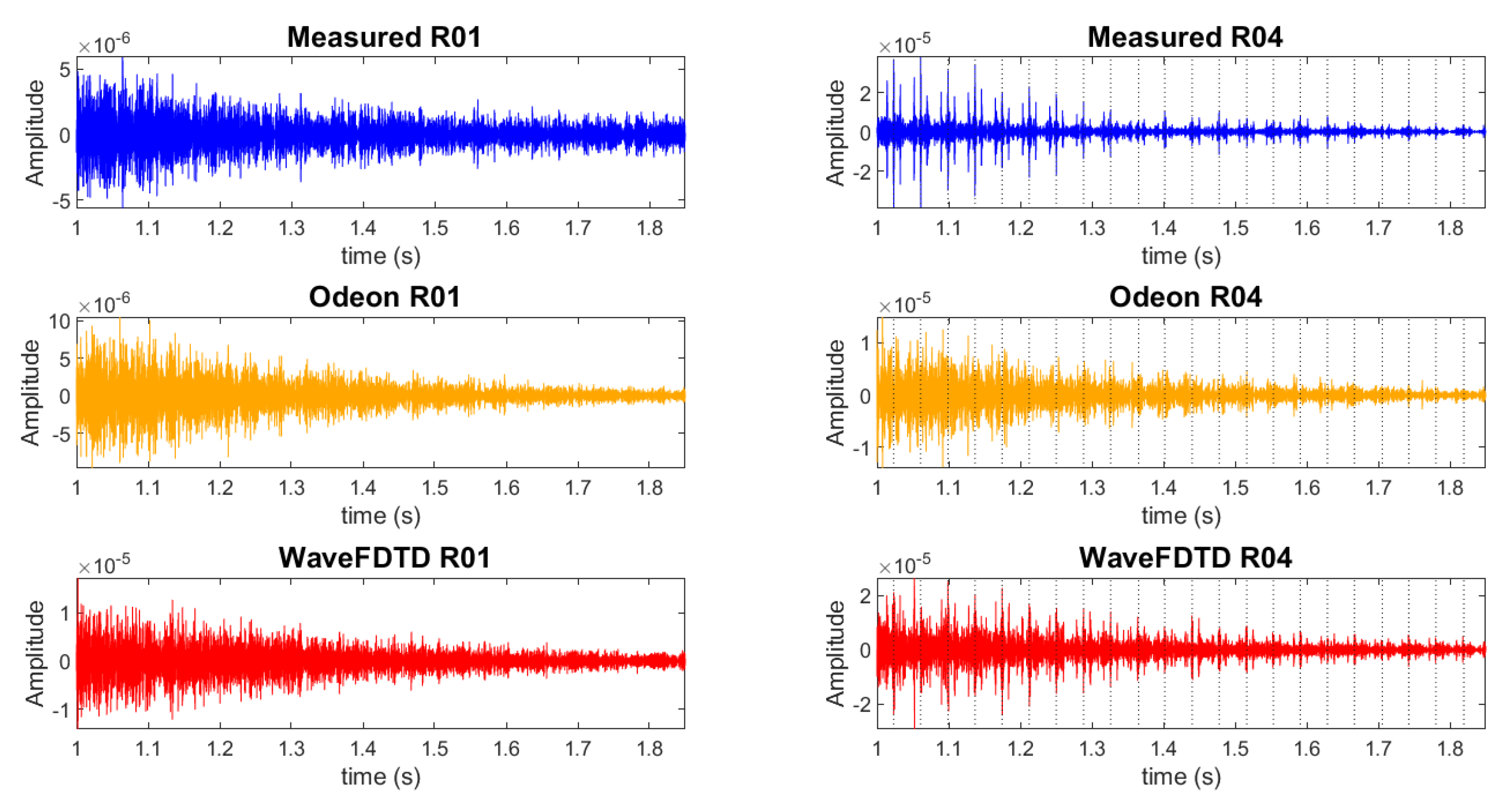


| Receiver | X | Y | Z |
|---|---|---|---|
| R01 | 8.90 | 3.80 | 1.50 |
| R02 | 9.60 | 1.90 | 1.50 |
| R03 | 5.00 | 6.65 | 1.00 |
| R04 | 5.00 | 6.65 | 1.50 |
| R05 | 5.00 | 6.65 | 2.00 |
| R06 | 1.66 | 6.65 | 1.50 |
| Material | 31 Hz | 63 Hz | 125 Hz | 250 Hz | 500 Hz | 1 kHz | 2 kHz | 4 kHz | 8 kHz | 16 kHz |
|---|---|---|---|---|---|---|---|---|---|---|
| Altar | 0.25 | 0.25 | 0.25 | 0.15 | 0.1 | 0.09 | 0.08 | 0.07 | 0.07 | 0.07 |
| Audience | – | 0.1 | 0.1 | 0.07 | 0.08 | 0.1 | 0.1 | 0.11 | 0.11 | – |
| Carpet | 0.08 | 0.08 | 0.08 | 0.24 | 0.57 | 0.69 | 0.71 | 0.73 | 0.73 | 0.73 |
| Ceiling | 0.19 | 0.19 | 0.19 | 0.06 | 0.05 | 0.08 | 0.07 | 0.05 | 0.05 | 0.05 |
| Panel | 0.2 | 0.42 | 0.89 | 1 | 1 | 1 | 1 | 1 | 1 | 1 |
| Seats | 0.44 | 0.44 | 0.44 | 0.56 | 0.67 | 0.74 | 0.83 | 0.87 | 0.87 | 0.87 |
| Tile | 0.015 | 0.015 | 0.015 | 0.015 | 0.005 | 0.005 | 0.005 | 0.005 | 0.005 | 0.005 |
| Walls | 0.19 | 0.19 | 0.19 | 0.06 | 0.05 | 0.08 | 0.07 | 0.05 | 0.05 | 0.05 |
| Window | 0.35 | 0.35 | 0.35 | 0.25 | 0.18 | 0.12 | 0.07 | 0.04 | 0.04 | 0.04 |
| Wavelet Level | Octave Band (Hz) |
|---|---|
| 7 | 250 |
| 6 | 500 |
| 5 | 1000 |
| 4 | 2000 |
| 3 | 4000 |
| 2 | 8000 |
| 1 | 16,000 |
© 2020 by the authors. Licensee MDPI, Basel, Switzerland. This article is an open access article distributed under the terms and conditions of the Creative Commons Attribution (CC BY) license (http://creativecommons.org/licenses/by/4.0/).
Share and Cite
Lai, H.; Hamilton, B. Computer Modeling of Barrel-Vaulted Sanctuary Exhibiting Flutter Echo with Comparison to Measurements. Acoustics 2020, 2, 87-109. https://doi.org/10.3390/acoustics2010007
Lai H, Hamilton B. Computer Modeling of Barrel-Vaulted Sanctuary Exhibiting Flutter Echo with Comparison to Measurements. Acoustics. 2020; 2(1):87-109. https://doi.org/10.3390/acoustics2010007
Chicago/Turabian StyleLai, Heather, and Brian Hamilton. 2020. "Computer Modeling of Barrel-Vaulted Sanctuary Exhibiting Flutter Echo with Comparison to Measurements" Acoustics 2, no. 1: 87-109. https://doi.org/10.3390/acoustics2010007
APA StyleLai, H., & Hamilton, B. (2020). Computer Modeling of Barrel-Vaulted Sanctuary Exhibiting Flutter Echo with Comparison to Measurements. Acoustics, 2(1), 87-109. https://doi.org/10.3390/acoustics2010007





